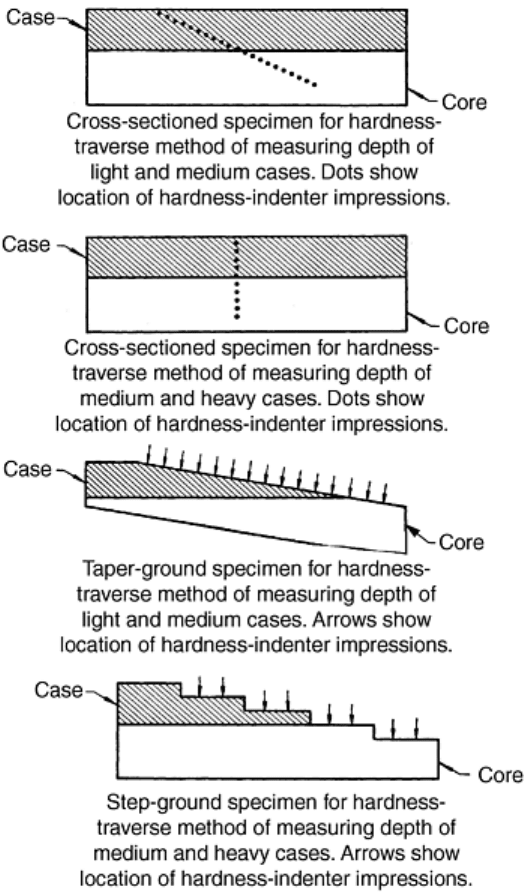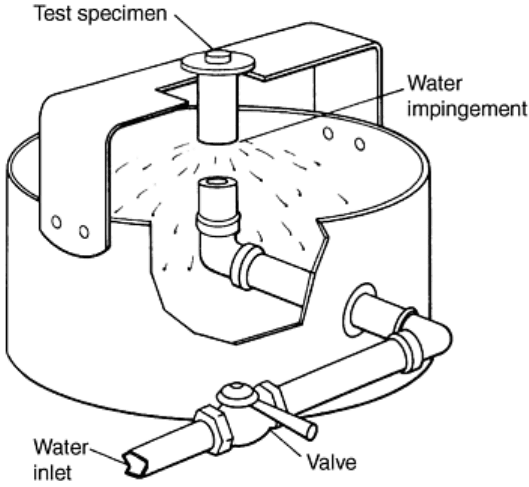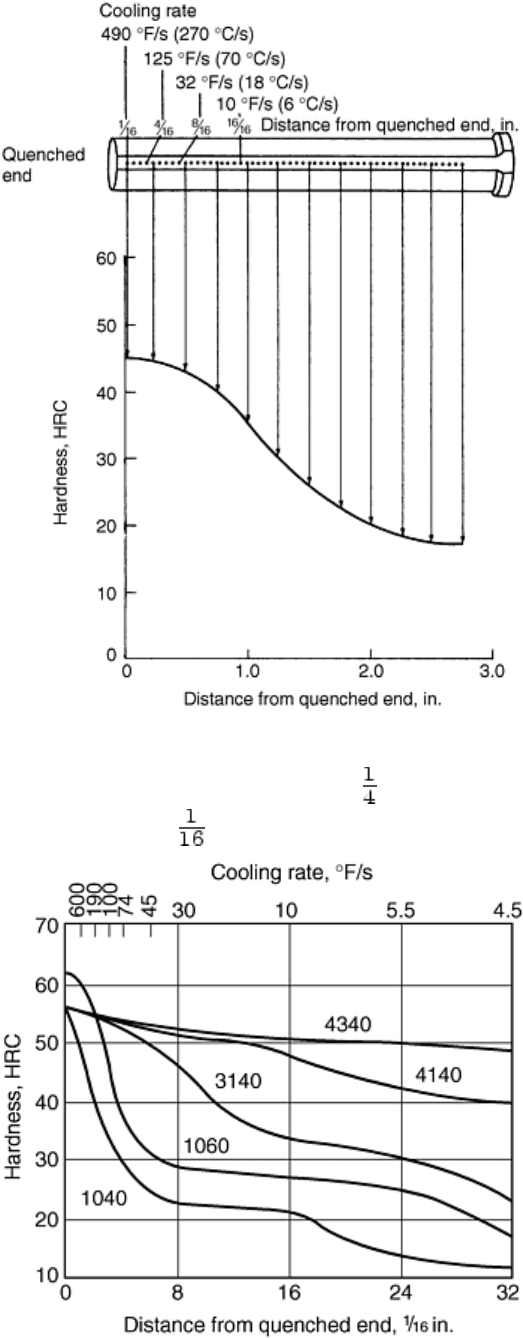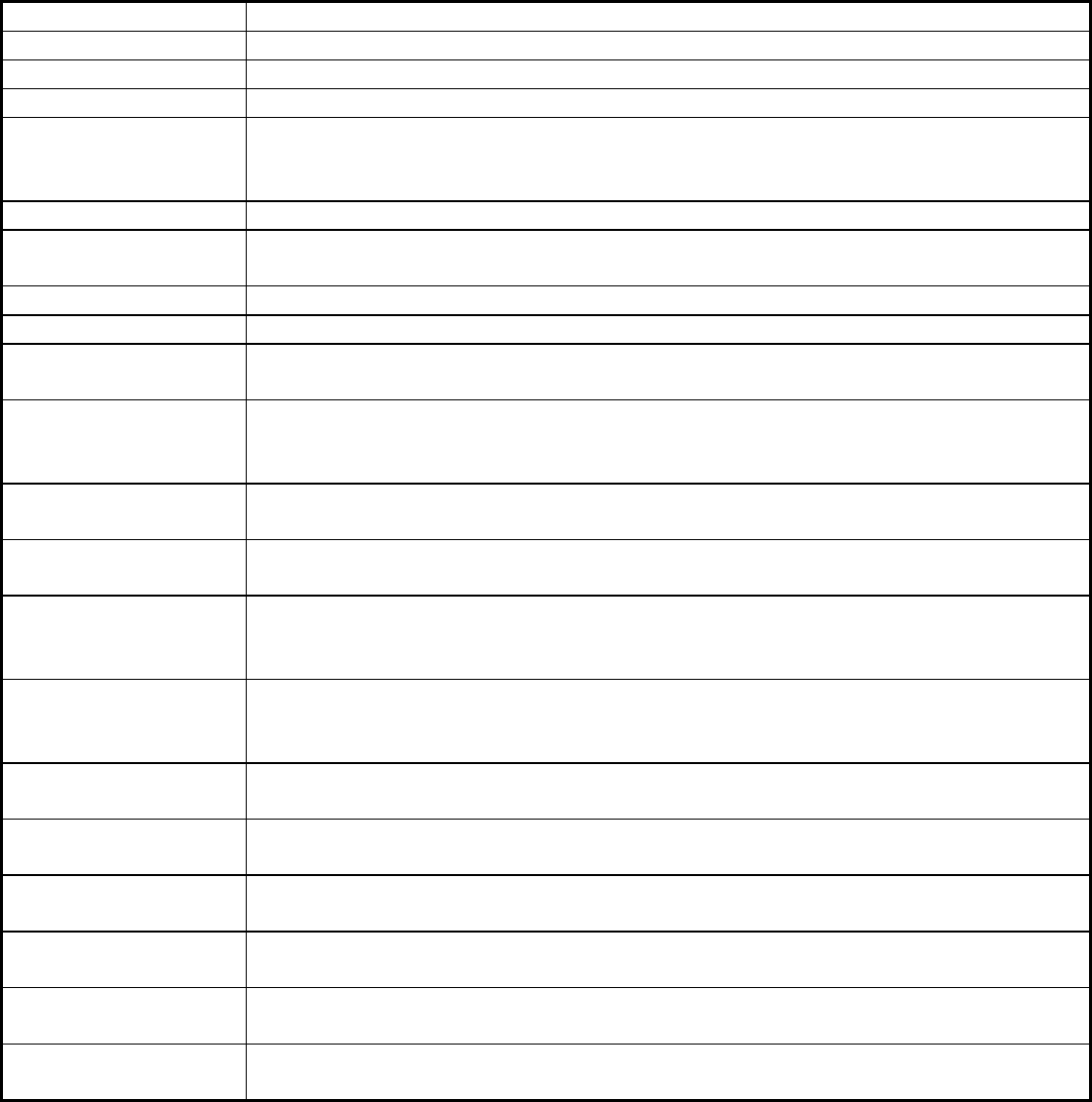ASM Metals HandBook Vol. 8 - Mechanical Testing and Evaluation
Подождите немного. Документ загружается.


Fig. 10 Hardness traverse methods for case-hardness profiling
Hardenability Testing
One of the important properties of alloyed steels is their ability to be hardened to a much greater depth than
plain-carbon steels. In many cases, they can be hardened throughout their entire thickness. The degree of depth
hardening is not the same for all alloying elements. Therefore, hardenability testing is used to evaluate the
hardening of steels.
A number of hardenability tests have been devised (principally by means of the Rockwell C scale), but the
Jominy end-quenching hardness test has proved to be the method with the highest degree of reproducibility. It
has been almost universally adopted in evaluating virtually all standard alloy steels and for some grades of
carbon steels. The test is relatively simple to perform and can produce much useful information for the
designer, as well as for the fabricator.
Jominy End-Quenching Hardness Test. Although variations are sometimes made to accommodate specific
requirements, the test bars for the end-quench test are normally 25 mm (1 in.) in diameter by 100 mm (4 in.)
long. The specimen has a collar on one end to hold it in a quenching jig (Fig. 11).

Fig. 11 Standard end-quench (Jominy) test specimen and method of quenching in
quenching jig
In this test, the water flow is controlled by a suitable valve so that the amount striking the end of the specimen
(Fig. 11) is constant in volume and velocity. The water impinges on the end of the specimen only and drains
away. By this means, cooling rates vary from about the fastest possible on the quenched end to very slow,
essentially equal to cooling in still air, on the opposite end. This results in a wide range of hardnesses along the
length of the bar.
After the test bar has been quenched, two opposite and flat parallel surfaces are ground along the length of the
bar to a depth of 0.381 mm (0.015 in.). Rockwell C hardness determinations then are made every 1.59 mm
(0.0625 in.). A specimen-holding indexing fixture is helpful for this operation for convenience, as well as for
accuracy. Such fixtures are available as accessory attachments for conventional Rockwell testers.
The next step is to record the readings and plot them on graph paper to develop a curve (Fig. 12). By comparing
the curves resulting from end-quench tests of different grades of steel (Fig. 13), relative hardenability can be
established. Steels with higher hardenability will be harder at a given distance from the quenched end of the
specimen than steels with lower hardenability. Thus, the flatter the curve is, the greater the hardenability will
be. On the end-quench curves, hardness usually is not measured beyond approximately 50 mm (2 in.) because
hardness measurements beyond this distance are seldom of any significance. At approximately 50 mm (2 in.)
from the quenched end, the effect of water on the quenched end has deteriorated, and the effect of cooling from
the surrounding air has become significant. An absolutely flat curve demonstrates conditions of very high
hardenability, which characterize an air-hardening steel, such as some highly alloyed steels.

Fig. 12 Method of developing end-quench curve by plotting hardness versus distance
from quenched end. Hardness plotted every 6.4 mm ( in.), although Rockwell C readings
were taken in increments of 1.59 mm ( in.), as shown on top of illustration.
Fig. 13 Plot of end-quench test results for five different steels
Additional information about Jominy end-quench hardenability is provided in the article “Quantitative
Prediction of Transformation Hardening in Steels” in Heat Treating, Volume 4 of ASM Handbook.

Introduction to Adhesion, Friction, and Wear
Testing
Peter J. Blau, Oak Ridge National Laboratory
Introduction
THE SURFACES OF SOLIDS play many different and important roles in technology. Their functions range
from imparting a pleasing appearance to protecting the underlying material from wear and corrosion, and from
bearing contact loads to serving as the substrates for coatings. The properties of free surfaces differ from those
of bulk materials. A variety of specialized testing methods, therefore, have been developed specifically for
characterizing the mechanical behavior of surfaces and the treatments and coatings applied to them.
In some engineering applications, like the bonding or fastening of parts, surfaces are placed in intimate contact
with the intention that they will not move relative to one another. In other cases, as in bearings, gears, brakes,
and rotating face seals, adjacent surfaces are intended to move relative to one another in a smooth and stable
fashion, while at the same time supporting a normal load. Sometimes, as in the attachment of protective
coatings to a surface, strong adhesion is desirable, but in other instances, as in the seizure and galling of sliding
bearings, strong adhesion is not desirable. Likewise, low friction might be desirable for a face seal but
undesirable for a brake pad. A high rate of abrasive wear for a paper mill slitter-knife blade is to be avoided, yet
the high abrasive wear rate associated with grinding prepares the surfaces of castings for mating with other
parts. Consequently, adhesion, friction, and wear are neither inherently good nor bad. Rather, they are
important to both the cosmetic and engineering functions of parts and must, therefore, be measured and
controlled.
Under some conditions, adhesion, friction, and wear are directly related, but under other conditions they are
not. For example, when clean metals rub against one another, adhesion can occur, raising the friction and
promoting the deformation and fracture of the softer material. The more extensive these processes are, the more
the wear. By contrast, there are cases in which the sliding friction of an interface can be relatively high (disc
brake pads against rotors), but the wear of the materials involved is relatively low. While appearing contrary to
intuition, the high-friction/low-wear situation becomes understandable when friction is viewed as the energy
available to do work on a material, and wear is but one of the possible ways in which a system can dissipate
that energy—conversion into heat being another. Thus, two sliding couples can possess nearly the same friction
coefficients but greatly different wear rates.
In this Section, tests designed specifically to evaluate the adhesion, friction, and wear behavior of various
material systems are described. Included within the wear category are other forms of surface damage, like
galling and scuffing. Unlike other mechanical properties, such as the elastic constants or shear strength,
properties of adhesion, friction, and wear depend strongly upon the surface conditions of the solid and not
exclusively upon its bulk structure. The selection of appropriate test methods to meet engineering requirements
for adhesion, friction, and wear, therefore, is somewhat complicated. Each functional requirement must be
analyzed on a case-by-case basis, and no one test is universally the best for measuring either adhesion, friction,
or wear.
Introduction to Adhesion, Friction, and Wear Testing
Peter J. Blau, Oak Ridge National Laboratory
Adhesion Testing

The article “Adhesion Testing” in this Section describes many different techniques and test methods that have
been devised for measuring the adhesion between solids. There is little standardization in this field, although
some investigators tend to favor one method over another. Most adhesion test methods are designed to assess
the ability of two materials to remain connected to one another despite the application of external or internal
body forces in various directions with respect to the interface. For example, different types of adhesion tests
have been designed to measure resistance to peeling, shearing, and delamination. In a few instances, adhesion
tests are used in the study of frictional phenomena that occur at a fine scale between protuberances on mating
surfaces. The article on adhesion testing contains a more complete discussion of these test methods and a
bibliography.
Introduction to Adhesion, Friction, and Wear Testing
Peter J. Blau, Oak Ridge National Laboratory
Friction Testing
Friction and wear are not basic properties of materials but rather represent the response of a material pair in a
certain environment to imposed forces, which tend to produce relative motion between the paired materials.
Friction and wear behavior is, therefore, subject to the considerations of testing geometry, the characteristics of
the relative motion, the contact pressure between the surfaces, the temperature, the stiffness and vibrational
properties of the supporting structures, the presence or absence of third bodies, the duration of contact, and the
chemistry of the environment in and around the interface. Tables of friction coefficients should not be trusted to
provide applicable numerical values unless the conditions used to develop the data closely mimic those of the
application for which the data are intended. Since frictional interactions occur under a wide variety of contact
conditions and size scales, selecting test methods for screening materials or lubricants for frictional behavior
should be done with care.
The article “Testing Methods for Solid Friction” describes a variety of methods that have proven useful in
measuring friction coefficients, both under static and kinetic conditions. Since frictional response is sometimes
sensitive to the preparation and cleaning of surfaces, these factors should be addressed when developing friction
testing procedures. Other testing variables, some of them rather subtle (like the fixture stiffness or thermal
conductivity), can affect friction test results in some cases. Frictional transitions, like running-in, are common
in engineering systems (Ref 1), so they should be considered when deciding on the type of data collection
method.
Standard test methods, like those produced by ASTM, can be useful not only as guides to friction testing
procedures but also as a source of information on which test variables should be controlled. Published
standards, like friction test methods in general, do not address all possible needs for friction measurement, and
thus, the engineer might need to devise his or her own tests to fit the situation.
Reference cited in this section
1. P.J. Blau, Friction Science and Technology, Marcel Dekker, Inc., 1996
Introduction to Adhesion, Friction, and Wear Testing
Peter J. Blau, Oak Ridge National Laboratory
Scratch Testing

Scratch tests are used for two main purposes:(a) to measure the adhesion of a coating or film to a surface, or (b)
to measure the resistance of a surface to damage from a harder opposing body. Scratch testing methods for the
former purpose are described in the article “Adhesion Testing.” Scratch tests used for the latter purpose are
described in the article “Scratch Testing” in this Volume. The use of scratch tests has a relatively long history,
having been introduced by the German mineralogist Friedrich Mohs in 1822 for identifying different mineral
species. The ability of a mineral to scratch or be scratched by another mineral is an important clue to its
identification, and use of the Mohs test persists to this day.
During recent years, scratch tests have been instrumented using force and acoustic emission sensors to provide
additional information for materials and coatings characterization. Diamond is the material of choice for most
scratch testing indenters, but diamond is not the only material used in scratch tests. Hardened steel files, for
example, are used for scratch testing under certain circumstances. New testing parameters, such as the critical
load for coating failure and the scratching coefficient (i.e., the normal force divided by the tangential force that
resists scratching), have been introduced to measure other surface properties. Scratch tests can be useful for
obtaining numerical rankings of the resistance of a material to single-point abrasion and for assessing the
mechanisms of material removal under abrasive conditions.
Introduction to Adhesion, Friction, and Wear Testing
Peter J. Blau, Oak Ridge National Laboratory
Testing for Wear and Surface Damage of Various Kinds
Because wear and surface damage take on many different forms, several articles on wear and surface damage
testing have been included in this Volume. Wear is a form of mechanically induced surface damage that results
in the progressive removal of material from a surface. Galling, chipping, or scratching can occur with one
contact event, and not being progressive, these phenomena are not strictly forms of wear. However, they still
fall under the category of surface damage. Because a great many types of surface damage occur in machinery,
different types of tests have been developed. The chapters in this Section describe quite a few of them, but it is
possible that a specialized method must be developed to effect a simulation of specific conditions or to isolate a
certain form of wear for detailed study.
Selection of the right type of test becomes critically important in order to achieve engineering relevance. In
fact, materials and surface treatments can rank in opposite order when tested for resistance to different forms of
wear (Ref 2). More than one type of wear can attack the same part, like both sliding and impact wear in printing
presses, and both erosive and abrasive wear on plastic extrusion machine screws. Sometimes wear can operate
in the presence of corrosive or chemically active environments, and synergistic chemomechanical effects are
possible. The selection of an appropriate wear testing method begins with an assessment of the type of wear
involved as well as the mechanical conditions and the environment that produced it.
Having a structured classification of wear types can make test selection easier. Different classification schemes
for wear have been developed because those who developed them have come from different backgrounds with
different experiences with wear. No one scheme is universally accepted, but most systems have similar features.
For example, mechanical wear can be classified by the type of relative motion: (a) tangential motion (sliding),
(b) impact, and (c) rolling (Ref 3). An abbreviated summary of the common wear and surface damage types,
categorized in this way, is given in Table 1. Formal definitions for the important types of wear are provided in
the ASM Handbook, Vol 18, Friction, Lubrication and Wear Technology (Ref 4). That Volume also contains
reviews of each major form of wear and comprehensive discussions of wear mechanisms, the wear of different
types of materials, and application-specific methods for wear control.

Table 1 Common types of wear and mechanical surface damage
Category Characteristics
Sliding wear Tangential motion and traction between surfaces
2 body abrasive wear Wear by fixed hard particles moving along a surface
3 body abrasive wear Wear by hard particles passing between opposing bodies
Adhesive wear Wear arising from the localized adhesion of one surface to another, which results in
plastic deformation and fracture with the transfer of detached material to the opposing
surface
Fretting wear Wear arising from short-amplitude oscillations or tangential contact vibrations
Fatigue wear Wear involving the nucleation and propagation of surface and/or subsurface cracks
under cyclic tangential forces arising from sliding contact
Polishing wear Fine-scale wear by the action of hard particles, chemomechanical processes, or both
Impact wear Normal forces acting cyclically on surfaces
Single-body impact
wear
Wear from the repeated impact of a second body
Multibody impact
wear
Wear from the repeated impact of particles, bubbles, droplets, or energy discharges.
Examples include particle impingement erosion, cavitation erosion (wear by
imploding bubbles), slurry erosion, and spark erosion.
Rolling contact wear Wear from the accumulation of surface damage during the cyclic stressing of one
body rolling over or along another
Surface damage other
than wear (examples)
Loss or displacement of material from a surface owing to mechanical contact in some
form
Chipping Removal of material from a surface, generally involving brittle crack propagation and
the production of shell-like features. Chipping commonly occurs at sharp corners or
edges of brittle contact surfaces.
Scuffing Plastic deformation of surface material by rubbing, which generally produces a
smooth appearance and is often localized in certain areas of the surface. Scuffing is
sometimes referred to as incipient galling.
Scratching Production of one or more shallow grooves in a surface by a hard counter body
moving tangentially along the surface
Galling A severe form of surface material displacement involving plastic deformation and the
loss of fit between counter surfaces
Gouging A severe form of localized plastic deformation in which relatively deep, localized
troughs are produced
Scoring Production of one or more deep scratches in a body generally involving plowing by a
hard particle or protuberance on an opposing body
False Brinelling Production of clusters of craters similar in appearance to hardness indentations with a
spherical indenter
Frosting The production of a dull appearance, typically on a bearing surface, due to a random
pattern of fine scratches or gouges
The descriptions given in the “Characteristics” column of Table 1 suggest that the use of wear terminology is
not without ambiguities. It is therefore important, when discussing or reporting on wear problems, to describe
the phenomena sufficiently well so that terminology ambiguities are avoided. Wear problems can be further
complicated by environmental interactions, such as oxidation or other surface chemical reactions, which occur
along with wear. In fact, some wear classification schemes list oxidational or chemical wear as major forms of
wear. Tests for most of the important forms of wear listed in Table 1 are described in this section. Sources for
information regarding impact wear, polishing wear, and other types not covered here are listed in the
bibliography.
Abrasive wear is one of the most economically important types of wear. The cost of damaged equipment, down
time, and materials loss attributable to abrasive wear in the mining and agriculture industries alone is
staggering. Several types of two-body and three-body abrasive wear tests are described. As with other types of

wear, more than one kind of test can be needed to establish the suitability of a given material, coating, or
surface treatment for complex abrasive environments.
Erosive wear, as indicated in Table 1, can involve removal of material by impinging solids, liquids, liquid-
entrained or gas-entrained solids, bubbles (cavitation erosion), or sparks. Like abrasive wear, erosive wear is a
costly form of wear in industry. It attacks piping, pumping equipment, turbomachinery, and conveyor systems.
Loose particles from erosive wear can also travel to other parts of a machine, creating secondary damage and
loss of function. The variables associated with different types of erosive wear tests commonly include
impingement angle, impingement velocity, screening by rebounding particles, and the shapes and sizes of the
erodent particles.
Sliding contact, like galling or scuffing, can produce surface damage with only one contact event, or it can be a
progressive form of wear like fretting or other repetitive contact types of wear. The article “Testing for Sliding
Contact Damage” in this Section describes several forms of sliding contact damage and the methods commonly
used to evaluate the resistance of materials to these damages.
Just as machines and their parts exist in a spectrum of sizes, friction and wear phenomena can also occur in
various size scales. Obviously, the fine-scale interfacial contact processes involved in nanoscale coatings on
hard disks require a different testing approach than the macroscale wear that occurs on the digger teeth of
mining equipment and on the bows of icebreakers. Therefore, not only are there different types of wear, like
abrasive wear, erosive wear, and so on, but there are also different size-scales of wear phenomena.
References cited in this section
2. H. Czichos, Tribology: A Systems Approach, Elsevier, Amsterdam, Netherlands, 1978, p 322–325
3. P.J. Blau, Wear Testing, Metals Handbook Desk Edition, ASM International, 1998, p 1342–1347
4. P.J. Blau, Glossary, Friction, Lubrication, and Wear Technology, Vol 18, ASM Handbook, ASM
International, 1992, p 1–21
Introduction to Adhesion, Friction, and Wear Testing
Peter J. Blau, Oak Ridge National Laboratory
Testing for Wear and Surface Damage of Various Kinds
Because wear and surface damage take on many different forms, several articles on wear and surface damage
testing have been included in this Volume. Wear is a form of mechanically induced surface damage that results
in the progressive removal of material from a surface. Galling, chipping, or scratching can occur with one
contact event, and not being progressive, these phenomena are not strictly forms of wear. However, they still
fall under the category of surface damage. Because a great many types of surface damage occur in machinery,
different types of tests have been developed. The chapters in this Section describe quite a few of them, but it is
possible that a specialized method must be developed to effect a simulation of specific conditions or to isolate a
certain form of wear for detailed study.
Selection of the right type of test becomes critically important in order to achieve engineering relevance. In
fact, materials and surface treatments can rank in opposite order when tested for resistance to different forms of
wear (Ref 2). More than one type of wear can attack the same part, like both sliding and impact wear in printing
presses, and both erosive and abrasive wear on plastic extrusion machine screws. Sometimes wear can operate
in the presence of corrosive or chemically active environments, and synergistic chemomechanical effects are
possible. The selection of an appropriate wear testing method begins with an assessment of the type of wear
involved as well as the mechanical conditions and the environment that produced it.

Having a structured classification of wear types can make test selection easier. Different classification schemes
for wear have been developed because those who developed them have come from different backgrounds with
different experiences with wear. No one scheme is universally accepted, but most systems have similar features.
For example, mechanical wear can be classified by the type of relative motion: (a) tangential motion (sliding),
(b) impact, and (c) rolling (Ref 3). An abbreviated summary of the common wear and surface damage types,
categorized in this way, is given in Table 1. Formal definitions for the important types of wear are provided in
the ASM Handbook, Vol 18, Friction, Lubrication and Wear Technology (Ref 4). That Volume also contains
reviews of each major form of wear and comprehensive discussions of wear mechanisms, the wear of different
types of materials, and application-specific methods for wear control.
Table 1 Common types of wear and mechanical surface damage
Category
Characteristics
Sliding wear
Tangential motion and traction between surfaces
2 body abrasive
wear
Wear by fixed hard particles moving along a surface
3 body abrasive
wear
Wear by hard particles passing between opposing bodies
Adhesive wear
Wear arising from the localized adhesion of one surface to another, which results
in plastic deformation and fracture with the transfer of detached material to the
opposing surface
Fretting wear
Wear arising from short-amplitude oscillations or tangential contact vibrations
Fatigue wear
Wear involving the nucleation and propagation of surface and/or subsurface
cracks under cyclic tangential forces arising from sliding contact
Polishing wear
Fine-scale wear by the action of hard particles, chemomechanical processes, or
both
Impact wear
Normal forces acting cyclically on surfaces
Single-body impact
wear
Wear from the repeated impact of a second body
Multibody impact
wear
Wear from the repeated impact of particles, bubbles, droplets, or energy
discharges. Examples include particle impingement erosion, cavitation erosion
(wear by imploding bubbles), slurry erosion, and spark erosion.
Rolling contact wear
Wear from the accumulation of surface damage during the cyclic stressing of one
body rolling over or along another
Surface damage other
than wear (examples)
Loss or displacement of material from a surface owing to mechanical contact in
some form
Chipping
Removal of material from a surface, generally involving brittle crack propagation
and the production of shell-like features. Chipping commonly occurs at sharp
corners or edges of brittle contact surfaces.
Scuffing
Plastic deformation of surface material by rubbing, which generally produces a
smooth appearance and is often localized in certain areas of the surface. Scuffing
is sometimes referred to as incipient galling.
Scratching
Production of one or more shallow grooves in a surface by a hard counter body
moving tangentially along the surface
Galling
A severe form of surface material displacement involving plastic deformation and
the loss of fit between counter surfaces
Gouging
A severe form of localized plastic deformation in which relatively deep, localized
troughs are produced
Scoring
Production of one or more deep scratches in a body generally involving plowing
by a hard particle or protuberance on an opposing body
False Brinelling
Production of clusters of craters similar in appearance to hardness indentations
with a spherical indenter
Frosting The production of a dull appearance, typically on a bearing surface, due to a

random pattern of fine scratches or gouges
The descriptions given in the “Characteristics” column of Table 1 suggest that the use of wear terminology is
not without ambiguities. It is therefore important, when discussing or reporting on wear problems, to describe
the phenomena sufficiently well so that terminology ambiguities are avoided. Wear problems can be further
complicated by environmental interactions, such as oxidation or other surface chemical reactions, which occur
along with wear. In fact, some wear classification schemes list oxidational or chemical wear as major forms of
wear. Tests for most of the important forms of wear listed in Table 1 are described in this section. Sources for
information regarding impact wear, polishing wear, and other types not covered here are listed in the
bibliography.
Abrasive wear is one of the most economically important types of wear. The cost of damaged equipment, down
time, and materials loss attributable to abrasive wear in the mining and agriculture industries alone is
staggering. Several types of two-body and three-body abrasive wear tests are described. As with other types of
wear, more than one kind of test can be needed to establish the suitability of a given material, coating, or
surface treatment for complex abrasive environments.
Erosive wear, as indicated in Table 1, can involve removal of material by impinging solids, liquids, liquid-
entrained or gas-entrained solids, bubbles (cavitation erosion), or sparks. Like abrasive wear, erosive wear is a
costly form of wear in industry. It attacks piping, pumping equipment, turbomachinery, and conveyor systems.
Loose particles from erosive wear can also travel to other parts of a machine, creating secondary damage and
loss of function. The variables associated with different types of erosive wear tests commonly include
impingement angle, impingement velocity, screening by rebounding particles, and the shapes and sizes of the
erodent particles.
Sliding contact, like galling or scuffing, can produce surface damage with only one contact event, or it can be a
progressive form of wear like fretting or other repetitive contact types of wear. The article “Testing for Sliding
Contact Damage” in this Section describes several forms of sliding contact damage and the methods commonly
used to evaluate the resistance of materials to these damages.
Just as machines and their parts exist in a spectrum of sizes, friction and wear phenomena can also occur in
various size scales. Obviously, the fine-scale interfacial contact processes involved in nanoscale coatings on
hard disks require a different testing approach than the macroscale wear that occurs on the digger teeth of
mining equipment and on the bows of icebreakers. Therefore, not only are there different types of wear, like
abrasive wear, erosive wear, and so on, but there are also different size-scales of wear phenomena.
References cited in this section
2. H. Czichos, Tribology: A Systems Approach, Elsevier, Amsterdam, Netherlands, 1978, p 322–325
3. P.J. Blau, Wear Testing, Metals Handbook Desk Edition, ASM International, 1998, p 1342–1347
4. P.J. Blau, Glossary, Friction, Lubrication, and Wear Technology, Vol 18, ASM Handbook, ASM
International, 1992, p 1–21
Introduction to Adhesion, Friction, and Wear Testing
Peter J. Blau, Oak Ridge National Laboratory
Adhesion, Friction, and Wear Testing Devices
Literally hundreds of devices for measuring adhesion, friction, and wear have been developed. Some of these
are commercially manufactured but most of them probably have been custom-designed for specific purposes.
This situation makes it difficult to compare the results from one study with those of another study unless the
appropriate correlation has been established. There is no simple answer to the problems arising from the
